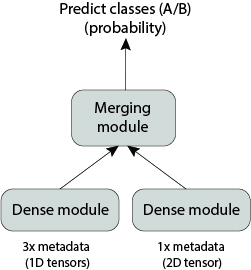As a first introduction to machine learning and keras, I just read Deep Learning with R by François Chollet with J.J. Allaire. I would like to extend the book's IMDB example of two-class classification to a multi-input version using functional API.
## Keras IMDB example
#load data
imdb <- dataset_imdb(num_words = 10000)
train_data <- imdb$train$x
train_labels <- imdb$train$y
test_data <- imdb$test$x
test_labels <- imdb$test$y
#Encoding the integer sequences into a binary matrix
vectorize_sequences <- function(sequences, dimension = 10000) {
results <- matrix(0, nrow = length(sequences), ncol = dimension)
for (i in 1:length(sequences))
results[i, sequences[[i]]] <- 1
results
}
x_train <- vectorize_sequences(train_data)
x_test <- vectorize_sequences(test_data)
y_train <- as.numeric(train_labels)
y_test <- as.numeric(test_labels)
#Defining the model
model <- keras_model_sequential() %>%
layer_dense(units = 16, activation = "relu", input_shape = c(10000)) %>%
layer_dense(units = 16, activation = "relu") %>%
layer_dense(units = 1, activation = "sigmoid")
#Compiling the model
model %>% compile(
optimizer = "rmsprop",
loss = "binary_crossentropy",
metrics = c("accuracy")
)
#Training the model
history <- model %>% fit(
partial_x_train,
partial_y_train,
epochs = 20,
batch_size = 512,
validation_data = list(x_val, y_val)
)
#Defining the model using functional API
model <- keras_model_sequential() %>%
layer_embedding(input_dim = 10000, output_dim = 8,
input_length = maxlen) %>%
layer_flatten() %>%
layer_dense(units = 1, activation = "sigmoid")
So, I would like to create a similar model where we predict class A and B based on 1 continuous and 3 categorical input data. In this dummy example, continuous1, categorical1 and categorical2 are 1D tensors while similarly to the IMDB example, categorical3 is a tensor of shape (samples, indices) where indices range from 1:20 and one-hot encoded.

#Dummy data
dat <- data.frame(samples=c(rep(paste0("A_",1:9800)),rep(paste0("B_",9801:10000))))
dat$label <- c(rep("A",9800),rep("B",200))
dat$continuous1 <- c(rnorm(9800, 100, 45),rnorm(200, 0, 25)) #may normalize to unit variance
dat$continuous1[dat$continuous1<0] <- 0
dat$categorical1 <- c(rep(1:100,98),rep(1:100,2))
dat$categorical2 <- c(rep(1:98,100),rep(99:100,100))
pool_A <- factor(1:15,levels=1:20)
pool_B <- factor(16:20,levels=1:20)
dat_categorical3 <- vector("list",10000)
names(dat_categorical3) <- c(as.character(dat[dat$label=="A",]$samples),as.character(dat[dat$label=="B",]$samples))
for(i in 1:9800){
dat_categorical3[[i]] <- (as.numeric(table(sample(pool_A, 20, replace=T))) > 0) + 0L
}
for(i in 9801:10000){
dat_categorical3[[i]] <- (as.numeric(table(sample(pool_B, 20, replace=T))) > 0) + 0L
}
As I've never built a Keras model before, I'm a bit confused on how to set up the layers representing the different data inputs using functional API. Any suggestions and feedback are highly appreciated, thanks!